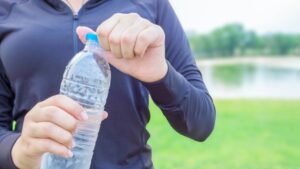Have you ever wondered how much water you should drink in a day? We all know that it’s important to stay hydrated, but how much is too little, and how much is too much? The answer to this question can vary depending on several factors such as your age, gender, body weight, and activity level. In addition, different units of measurement are used to express recommended water intake, which can make things complicated. In this blog post, we’ll explain the recommended daily water intake in all units and give you some tips on how to stay hydrated. So, grab a glass of water and let’s dive in!
I. Importance of drinking enough water
Drinking enough water is crucial for maintaining good health. Water makes up a significant portion of our body weight and is involved in numerous bodily functions such as carrying nutrients and oxygen to cells, regulating body temperature, flushing out toxins, and keeping tissues and organs functioning properly. The benefits of staying hydrated include improved digestion, better skin health, and increased energy levels. While there isn’t a one-size-fits-all approach to determining daily water intake, experts recommend that healthy adults drink between 11 and 15.5 cups of fluids daily, which can include water, tea, coffee, and other hydrating beverages. Staying hydrated is especially important during physical activity, exposure to hot weather, and certain health conditions, so it’s important to listen to your body’s thirst cues and drink enough water to stay properly hydrated.
Recommended daily intake of water
Staying hydrated is important for your overall health and well-being. The recommended daily intake of water varies depending on various factors such as age, gender and physical activity level. Studies show that men should drink about 13 cups of water or three liters per day while women should aim for about nine cups or a little over two liters. However, these recommendations also cover fluids from other beverages and food. It’s important to keep an eye on the color of your urine and aim for a colorless or light yellow. Other factors, such as climate, physical activity and health conditions, can affect your need for water. If you’re exercising, remember to add 12 ounces of water to your daily intake for every 30 minutes of exercise. So, make sure to hit your daily water intake recommendation to keep your body functioning properly.
Different units used to measure water intake
When it comes to water intake, there are several units that we use to measure it. The most common ones are fluid ounces (fl oz), milliliters (ml), cups, liters (L), and gallons (gal). Each unit has its own conversion factor, so it’s important to know which one you’re using to get an accurate measurement. For example, 8 fl oz is equal to 236.6 ml, while 1 L is equal to 33.8 fl oz or 4.2 cups. The unit you use may also depend on where you live, as some countries use different units than others. Regardless of the unit you use, it’s important to stay hydrated to maintain bodily functions, especially during physical activity, in different climates, and when dealing with certain health conditions.
II. Units to measure water intake
A. Fluid ounces (fl oz)
Fluid ounces or fl oz is one of the most popular units of measurement used for liquids, especially in the United States. One fluid ounce is equivalent to about 29.5735 milliliters, which is roughly equivalent to the amount of water in a shot glass. In terms of daily water intake, the National Academies of Sciences, Engineering, and Medicine suggest that adult men should aim for about 125 ounces or 15.5 cups of water per day, while adult women should aim for about 91 ounces or 11.5 cups. These recommendations include all fluids from water, other beverages, and food. It is important to note that the amount of water you need can vary based on factors such as your location, diet, physical activity, and overall health status. So be sure to listen to your body and adjust your fluid intake accordingly.
B. Milliliters (ml)
When it comes to measuring your daily intake of water, you may come across some unfamiliar units, such as milliliters (ml). Milliliters are a metric unit often used in scientific and medical settings, and it is equal to one thousandth of a liter. While you may not be used to measuring your intake of anything in milliliters, it’s a helpful unit to know when tracking your daily water consumption. To give you an idea of how much water you should drink, the National Academies of Sciences, Engineering, and Medicine recommend about 15.5 cups (3.7 liters) of fluids a day for men, and about 11.5 cups (2.7 liters) of fluids a day for women. Remember, these recommendations cover fluids from water, other beverages, and food. So, if you want to track your daily water intake in milliliters, just remember that one liter of water equals 1000 ml.
C. Cups
When it comes to measuring your water intake, cups are one of the most commonly used units. Many people find it easier to track their daily water goal by using cups, as it is a simple measurement that is readily available in most households. One cup of water equals 8 fluid ounces or 236 milliliters. So, if you’re aiming to drink 8 cups a day, you will need to consume 64 fluid ounces or 1.9 liters. While this is a good general guideline, it’s important to remember that your specific water needs may vary due to factors such as your age, gender, activity level, diet, and climate. Therefore, it’s essential to listen to your body’s thirst signals and consult with your doctor to determine the optimal daily water intake for you.
D. Liters (L)
When it comes to measuring water intake, one unit that is commonly used is liters (L). A liter is equivalent to 33.8 fluid ounces or 4 cups of water. This unit is often used in countries that use the metric system and is a useful way to measure daily water intake since the recommended daily amount for men is 3.7 liters and for women is 2.7 liters. When drinking water from a water bottle or filling up a glass, you can easily determine how much you have consumed in liters. It is important to keep track of your water intake to ensure that you are meeting your daily requirements and staying hydrated. So next time you refill your water bottle, keep in mind the liters you are consuming and strive to reach your daily intake goals.
E. Gallons (gal)
Gallons are another unit used to measure water intake. A gallon of water is equal to 128 ounces. While the recommended daily intake of water in ounces may seem daunting, it may be easier to conceptualize in gallons. For example, a woman may need to drink 2.3 liters, or approximately 0.6 gallons, of water per day, while a man may need to drink 3.3 liters, or almost 0.9 gallons, of water per day. It’s important to note that these recommendations may vary based on factors such as activity level and climate. Drinking enough water is crucial for maintaining proper bodily function, hydration, and overall health. So, whether you prefer to measure your water intake in gallons or another unit, make sure to stay hydrated throughout the day.
III. Water Intake Guidelines
A. Daily water intake recommendations
It’s important to drink enough water every day to stay hydrated and maintain good health. According to the National Academies of Sciences, Engineering, and Medicine (NASEM), the recommended daily intake of water for healthy adults is approximately 3.7 liters (15.5 cups or 125 ounces) for men and 2.7 liters (11.5 cups or 91 ounces) for women. However, it’s important to note that this recommendation varies based on factors such as age, gender, and activity level. It’s also important to consider the climate, physical activity, diet, and health conditions when determining your daily water intake needs. Remember, listening to your body and staying hydrated is crucial for optimal health.
1. National Academies of Sciences, Engineering, and Medicine (NASEM)
The National Academies of Sciences, Engineering, and Medicine (NASEM) is a respected scientific national academy that provides independent and objective advice to inform policy with evidence, spark progress, and innovation, and confront challenging issues for the benefit of society. Comprised of scientists, engineers, and health professionals, NASEM serves as the collective scientific voice of the United States. Its three sub-divisions that operate as quasi-independent honorific member organizations are known as the National Academy of Sciences (NAS), the National Academy of Engineering (NAE), and the National Academy of Medicine (NAM). Through their research and publications, the National Academies play a vital role in informing and advancing policy across a wide range of fields.
2. World Health Organization (WHO)
According to the World Health Organization (WHO), the recommended daily water intake for males is 2.9 liters and for females is 2.2 liters. However, these guidelines can vary depending on factors such as age, gender, climate, physical activity level, and diet. It is important to stay hydrated with water as it is the most effective way to replenish fluids in the body. Drinks such as soda, coffee, and tea may not count as much towards daily fluid intake as they may actually dehydrate the body. Monitoring urine color and frequency can be a good indicator of hydration levels, as well as pre-hydrating before engaging in physical activity. Drinking enough water is essential for maintaining good health and preventing dehydration.
3. European Food Safety Authority (EFSA)
The European Food Safety Authority (EFSA) has set guidelines for adequate water intake based on specific age groups. These recommendations include water from all beverages and food moisture in moderate environmental temperatures and physical activity levels. Adequate Intakes (AI) have been established from observed intake data, desirable urine osmolarity values, and desirable water volumes per energy unit consumed. For infants in their first year of life, an estimated total water intake of 800-1000 mL/day is considered adequate. AI for children range from 1300 mL/day for boys and girls aged 2-3 to 1900 mL/day for girls and 2100 mL/day for boys aged 9-13. Adolescents of 14 years and older are considered as adults with respect to adequate water intake. Available data for adults permit AIs of 2.0 L/day for females and 2.5 L/day for males.
B. Factors affecting water intake needs
When it comes to how much water you should drink, it is not one size fits all. Your daily water intake needs are affected by several factors, including age, gender, and activity level. For example, pregnant or breastfeeding women need to increase their fluid intake by 24 to 32 ounces depending on their weight. Additionally, physical activity increases your water needs, with the general rule of adding 12 ounces of water to your daily intake for every 30 minutes of exercise. Other factors such as climate, diet, and health conditions also impact your water intake needs. It’s important to monitor your body’s signals and stay hydrated by drinking fluids before you feel thirsty. Remember, if you’re adequately hydrated, you should be urinating about once every two to four hours, and your urine should be a very pale yellow color.
1. Age
Age is an important factor to consider when determining daily water intake needs. The National Academies of Sciences, Engineering, and Medicine (NASEM) recommends that adult men should consume around 3.7 liters (125 ounces) of water per day and adult women should consume about 2.7 liters (91 ounces) of water each day. Children, on the other hand, need less water than adults. The Children’s Hospital of Orange County (CHOC) recommends that children drink the number of 8-ounce cups of water equal to their age, with a minimum of 64 ounces of water for children over the age of 8. However, it’s important to note that individual needs can vary based on activity level, climate, and health conditions. Always talk to your doctor before significantly increasing or decreasing your water intake.
2. Gender
Gender is one of the factors that can affect a person’s daily water intake needs. Women typically need to drink less water than men due to differences in body size and composition. The National Academies of Sciences, Engineering, and Medicine recommend a daily intake of 2.7 liters (11.5 cups or 91 ounces) for women and 3.7 liters (15.5 cups or 125 ounces) for men. It’s important to note that these are general recommendations and individual needs may vary based on factors such as activity level, diet, and climate. Additionally, pregnant and breastfeeding women may need to increase their fluid intake by 24 to 32 ounces depending on their weight. Overall, it’s important to listen to your body and stay adequately hydrated to maintain optimal health.
3. Activity level
Your activity level plays a significant role in determining how much water you should drink. When you exercise, your body loses water through sweat, which increases your fluid intake needs. According to the American College of Sports Medicine, you should add 12 ounces of water to your daily intake for every 30 minutes of activity. If you exercise outdoors in hot conditions, you may need to consume even more water to prevent dehydration. Age and gender also affect your hydration needs. Pregnant or breastfeeding women require additional fluid intake, and older adults may be more at risk of dehydration due to a decrease in their thirst response. By staying mindful of your activity level and other factors that affect your hydration needs, you can stay well-hydrated and enjoy the many benefits of drinking enough water.
IV. Factors affecting water intake
A. Climate
When it comes to how much water you should be drinking daily, climate plays an important role in determining your intake needs. Hot and humid weather can cause you to sweat more, leading to higher fluid losses. This means you need to drink more water to stay hydrated. On the other hand, cooler and drier weather can also lead to dehydration as the chilly air can dry out your skin and respiratory system. Therefore, it’s important to drink enough water to make up for the fluid losses and keep your body hydrated regardless of the climate conditions. Ultimately, it’s best to listen to your body and drink water when you feel thirsty. Don’t wait until you’re severely dehydrated to start drinking water, as it may lead to health complications.
B. Physical activity
The amount of water you need to drink daily is affected by your level of physical activity. When you exercise, your body loses fluids through sweat, which must be replaced by drinking water. The American College of Sports Medicine recommends adding 12 ounces of water to your daily intake for every 30 minutes that you plan to work out. It’s essential to replace fluids lost through sweat to maintain normal body function and performance levels. If you’re an athlete, it’s best to seek advice from a health professional on fluid replacement. When you’re dehydrated, you may experience symptoms such as darker urine and lack of sweat during exercise. The colour of your urine is a good indicator of dehydration; if it’s pale and clear, you’re well hydrated, but if it’s dark, you need to drink more fluids. Remember, the general rule is that if you’re sweating, you need to be drinking fluids.
C. Diet
C. Diet is an important factor that affects our daily intake of water. The type and amount of food we consume can increase or decrease our need for water. For example, foods with high water content, such as fruits and vegetables, can contribute to our daily water intake. On the other hand, foods high in salt, sugar, and caffeine can increase our need for water. It’s important to pay attention to the food we’re consuming and how it’s affecting our body’s hydration levels. Drinking enough water can also aid in weight loss by helping to reduce calorie intake, especially when replacing high-calorie beverages with water. Remember, the key is to listen to your body and drink enough water to maintain good health and hydration levels.
D. Health conditions
When it comes to hydration, it’s important to consider any pre-existing health conditions. Certain medical conditions can increase the body’s need for water, such as kidney disease, diabetes, and heart failure. On the other hand, some health conditions may require individuals to limit their fluid intake, such as those with edema or high blood pressure. It’s crucial to consult with a healthcare provider to determine your specific fluid intake needs based on your individual health status. Additionally, certain medications may affect fluid balance in the body and impact hydration needs. It’s always important to communicate any medications you are taking to your healthcare provider to ensure adequate hydration and avoid any adverse side effects. By being mindful of any health conditions and seeking guidance from a healthcare provider, you can ensure you are meeting your body’s specific hydration needs.




